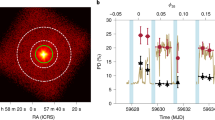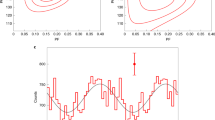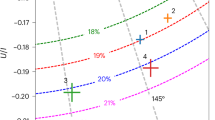Abstract
The study of astronomical objects using electromagnetic radiation involves four basic observational approaches: imaging, spectroscopy, photometry (accurate counting of the photons received) and polarimetry (measurement of the polarizations of the observed photons). In contrast to observations at other wavelengths, a lack of sensitivity has prevented X-ray astronomy from making use of polarimetry. Yet such a technique could provide a direct picture of the state of matter in extreme magnetic and gravitational fields1,2,3,4,5,6, and has the potential to resolve the internal structures of compact sources that would otherwise remain inaccessible, even to X-ray interferometry7. In binary pulsars, for example, we could directly ‘see’ the rotation of the magnetic field and determine if the emission is in the form of a ‘fan’ or a ‘pencil’ beam1,8. Also, observation of the characteristic twisting of the polarization angle in other compact sources would reveal the presence of a black hole9,10,11,12. Here we report the development of an instrument that makes X-ray polarimetry possible. The factor of 100 improvement in sensitivity that we have achieved will allow direct exploration of the most dramatic objects of the X-ray sky.
This is a preview of subscription content, access via your institution
Access options
Subscribe to this journal
Receive 51 print issues and online access
$199.00 per year
only $3.90 per issue
Buy this article
- Purchase on Springer Link
- Instant access to full article PDF
Prices may be subject to local taxes which are calculated during checkout



Similar content being viewed by others
References
Mészáros, P., Novick, R., Chanan, G. A., Weisskopf, M. C. & Szentgyörgyi, A. Astrophysical implication and observational prospects of X-ray polarimetry. Astrophys. J. 324, 1056–1067 (1988).
Rees, M. J. Expected polarization properties of binary X-ray sources. Mon. Not. R. Astron. Soc. 171, 457–465 (1975).
Sunyaev, R. A. & Titarchuk, L. G. Comptonization of low-frequency radiation in accretion disks: angular distribution and polarization of hard radiation. Astron. Astrophys. 143, 374–388 (1985).
Gnedin, Yu. N., Pavlov, G. G. & Shibanov, Yu. A. The effect of vacuum birefringence in a magnetic field on the polarization and beaming of X-ray pulsars. Sov. Astron. Lett. 4, 117–119 (1978).
Ventura, J. Scattering of light in strongly magnetized plasma. Phys. Rev. D 19, 1684–1695 (1979).
Mészáros, P. & Ventura, J. Vacuum polarization effects on radiative opacities in strong magnetic field. Phys. Rev. D 19, 3565–3575 (1979).
Cash, W., Shapley, A., Osterman, S. & Marshall, J. Laboratory detection of X-ray fringes with grazing-incidence interferometer. Nature 407, 160–162 (2000).
Gnedin, Yu. N. & Sunyaev, R. A. Polarization of optical and X-ray radiation from compact thermal sources with magnetic field. Astron. Astrophys. 36, 379–394 (1974).
Connors, P. A. & Stark, R. F. Observable gravitational effects on polarized radiation coming from near a black hole. Nature 269, 128–129 (1977).
Stark, R. F. & Connors, P. A. Observational test for the existence of a rotating black hole in Cyg X-1. Nature 266, 429–430 (1977).
Connors, P. A., Piran, T. & Stark, R. Polarization features of X-ray radiation emitted near a black hole. Astrophys. J. 235, 224–244 (1980).
Bao, G., Wiita, P. & Hadrava, P. Energy-dependent polarization variability as a black hole signature. Phys. Rev. Lett. 77, 12–15 (1996).
Celotti, A. & Matt, G. Polarization properties of synchrotron self-Compton emission. Mon. Not. R. Astron. Soc. 268, 451–458 (1994).
Poutanen, J. Relativistic jets in blazars: polarization of radiation. Astrophys. J. Suppl. Ser. 92, 607–609 (1994).
Tanaka, Y. et al. Gravitationally redshifted emission implying an accretion disk and massive black-hole in the active galaxy MCG-6-30-15. Nature 375, 659–661 (1995).
Ogura, J., Nobuyori, O. & Kojima, Y. Profiles and polarization properties of emission lines from relativistic disks. Publ. Astron. Soc. Jpn 52, 841–845 (2000).
Matt, G., Fabian, A. C. & Ross, R. R. X-ray photoionized accretion discs: UV and X-ray continuum spectra and polarization. Mon. Not. R. Astron. Soc. 264, 839–852 (1993).
Novick, R., Weisskopf, M. C., Berthelsdorf, R., Linke, R. & Wolff, R. S. Detection of X-ray polarization of the Crab Nebula. Astrophys. J. 174, L1–L8 (1972).
Weisskopf, M. C., Silver, E. H., Kestenbaum, H. L., Long, K. S. & Novick, R. A precision measurement of the X-ray polarization of the Crab Nebula without pulsar contamination. Astrophys. J. 220, L117–L122 (1978).
Kaaret, P. et al. SXRP: a focal plane stellar X-ray polarimeter for the Spectrum-X-Gamma mission. Opt. Eng. 29, 773–783 (1990).
Schnopper, H. W. & Kalata, K. Polarimeter for celestial X-rays. Astron. J. 74, 854–858 (1969).
Novick, R. in Planets, Stars and Nebulae Studied with Photopolarimetry (ed. Gerehls, T.) 262–317 (Univ. Arizona Press, Tucson, 1972).
Riegler, G. R., Garmire, G. P., Moore, W. E. & Stevens, J. A low-energy X-ray polarimeter. Bull. Am. Phys. Soc. 15, 635 (1970).
Tsunemi, H. et al. Detection of X-ray polarization with a charge coupled device. Nucl. Instrum. Methods A 321, 629–631 (1992).
Buschhorn, G. et al. X-ray polarimetry using the photoeffect in a CCD detector. Nucl. Instrum. Methods A 346, 578–588 (1994).
Soffitta, P. et al. Astronomical X-ray polarimetry based on photoelectric effect with microgap detectors. Nucl. Instrum. Methods A (in the press); also preprint astro-ph/0012183 at 〈http://xxx.lanl.gov〉 (2000).
Angelini, F. et al. The micro-gap chamber. Nucl. Instrum. Methods A 335, 69–77 (1993).
Austin, R. A., Minamitani, T. & Ramsey, B. Development of a hard X-ray imaging polarimeter. Proc. SPIE 2010, 118–125 (1993).
La Monaca, A. et al. A new photoelectron imager for X-ray astronomical polarimetry. Nucl. Instrum. Methods A 416, 267–277 (1998).
Sauli, F. GEM: a new concept for electron amplification in gas detectors. Nucl. Instrum. Methods A 386, 531–534 (1997).
Campbell, M. et al. A pixel readout chip for 10–30 Mrad in standard 0.25 µm CMOS. IEEE Trans. Nucl. Sci. 46, 156–160 (1999).
Bavdaz, M. et al. Status of the X-ray evolving universe spectroscopy mission (XEUS). Proc. SPIE 4138, 69–78 (2000).
Christensen, F. E. et al. X-ray calibration of the SODART flight telescope. Proc. SPIE 3113, 69–78 (1997).
Acknowledgements
This work is partially supported by the Italian Space Agency (ASI).
Author information
Authors and Affiliations
Corresponding author
Rights and permissions
About this article
Cite this article
Costa, E., Soffitta, P., Bellazzini, R. et al. An efficient photoelectric X-ray polarimeter for the study of black holes and neutron stars. Nature 411, 662–665 (2001). https://doi.org/10.1038/35079508
Received:
Accepted:
Published:
Issue Date:
DOI: https://doi.org/10.1038/35079508
This article is cited by
-
Gas microchannel plate-pixel detector for X-ray polarimetry
Nuclear Science and Techniques (2024)
-
Studies of the linearity of the readout module assembling using the eXTP-GPD chips
Radiation Detection Technology and Methods (2023)
-
Establishment and study of a polarized X-ray radiation facility
Nuclear Science and Techniques (2023)
-
Application of the observation simulator in the eXTP mission
Experimental Astronomy (2023)
Comments
By submitting a comment you agree to abide by our Terms and Community Guidelines. If you find something abusive or that does not comply with our terms or guidelines please flag it as inappropriate.



